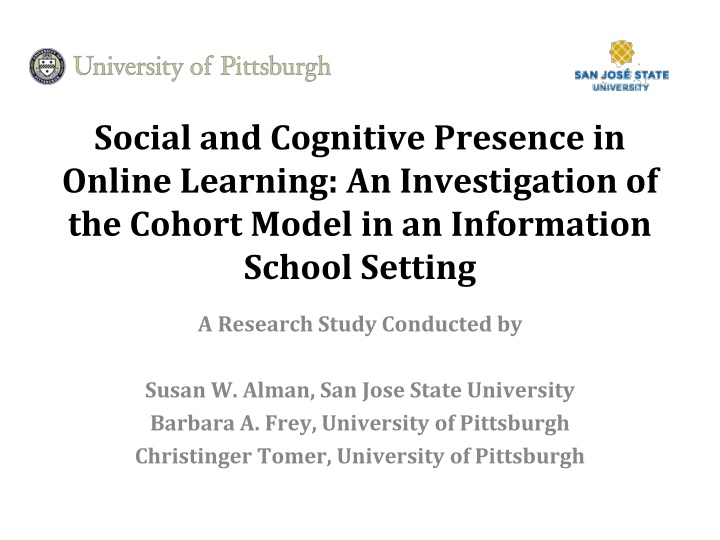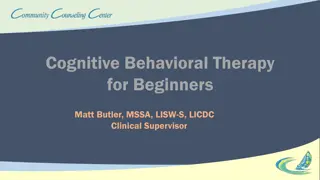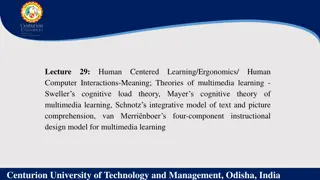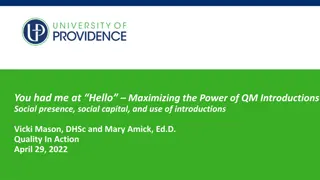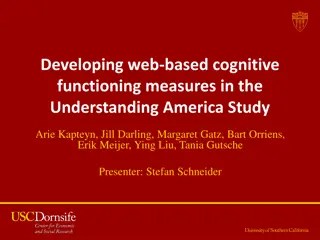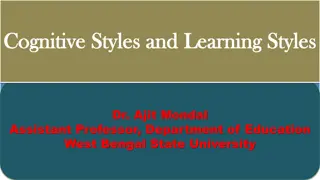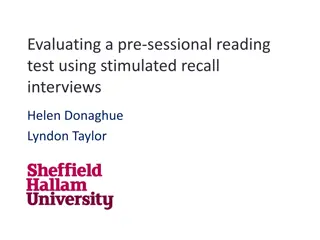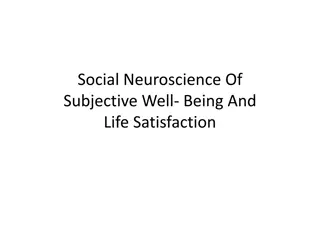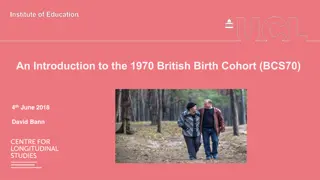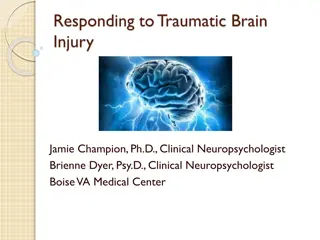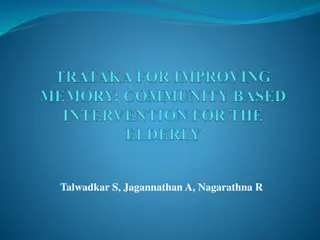Exploration of Social and Cognitive Presence in Online Learning Cohorts
Investigation conducted at San Jose State University and University of Pittsburgh compares student satisfaction in cohort and non-cohort programs. Cohorts offer a sense of community, belonging, and shared learning experiences. Limited empirical evidence exists on cohort benefits in online education. Observations show high attrition in individual-based online programs versus low attrition in cohort-based communities. Survey instruments developed to assess teaching, social, and cognitive presence in online courses.
Download Presentation

Please find below an Image/Link to download the presentation.
The content on the website is provided AS IS for your information and personal use only. It may not be sold, licensed, or shared on other websites without obtaining consent from the author.If you encounter any issues during the download, it is possible that the publisher has removed the file from their server.
You are allowed to download the files provided on this website for personal or commercial use, subject to the condition that they are used lawfully. All files are the property of their respective owners.
The content on the website is provided AS IS for your information and personal use only. It may not be sold, licensed, or shared on other websites without obtaining consent from the author.
E N D
Presentation Transcript
Social and Cognitive Presence in Online Learning: An Investigation of the Cohort Model in an Information School Setting A Research Study Conducted by Susan W. Alman, San Jose State University Barbara A. Frey, University of Pittsburgh Christinger Tomer, University of Pittsburgh
Purpose of Study The purpose of this study was to compare student satisfaction in cohort and non-cohort programs.
Cohort Concept Group of students who stay together from the beginning to the end of an academic program. They grow through the process while developing community and experiencing essentially the same course material and challenges. (Adapted from K. Fenning, College Quarterly, Winter 2004) More than merely a method of course delivery it provides students with a sense of belonging, supports risk taking, creates an environment of respect, and promotes multiple perspective (Imel, 2002 cited in Slemp, 2005)
Research Related to Cohort Experience Benefits of the cohort experience are cited frequently, but there is little empirical evidence available Only one paper addresses the issue directly: 2004 (Tisdell, Elizabeth J.,et al. "Cohort Learning Online in Graduate Higher Education: Constructing Knowledge in Cyber Community." Educational Technology & Society 7, no. 1 (2004): 115-127) Sample size and population limit the applicability findings: 2005 (Manos, Angel Barringer, et al. "A case study of education Ph. D. cohort students: Factors related to stress." The Journal of Continuing Higher Education 53, no. 2 (2005): 24-33) Deals with cohort learning, but only tangentially: 2012 (Chu, Regina Juchun, et al. "Transformation for adults in an Internet-based learning environment-is it necessary to be self-directed?." British Journal Of Educational Technology 43, no. 2 (2012): 205-216)
Cohort Experience Observations High Attrition in Online Programs with Individual Students Low Attrition in Online Programs that have Cohort-based Communities Power of the cohort. Power of online learning community. More than 800 students organized in 20 cohorts since 2001. Student capabilities enhanced Confident Motivated Satisfied
Survey Development Survey Instrument Developed Using: Community of Inquiry Survey http://communitiesofinquiry.com/metho dology Teaching Presence Social Presence Cognitive Presence Online Courses
Questionnaire Teaching Presence: 7 Questions Social Presence: 18 Questions Cognitive Presence: 7 Questions Online Course Experiences: 11 Questions Demographics: 12
Survey Population Students enrolled in Master of Library and Information Science program at the University of Pittsburgh. Continuing students: First, Second, Third and Fourth Term Mixture of Students: Full-time/Part-time Member of a Cohort/NOT in a Cohort On-campus and Online students
Population Queried Students enrolled in two courses/4 sections during Summer Term 2011 2 Sections: Weekly f2f 2 Sections: Asynchronous with one f2f meeting Some students were enrolled in both courses. Administration of Instrument Survey Monkey
Student Population N=71 Students enrolled in one of four sections of summer courses 17 students graduated in August Adjusted N=54 67% Rate of Response: 36/54
Data Analysis High Rate of Response Sufficient for Analysis and Comparison Even Distribution of Responses from Both Groups Wilcoxon Mann-Whitney Nonparametric Test Compare 2 Populations and Indicate Statistically Significant Differences Between 2 Groups
Findings Statistically Significant Difference in Responses Made by the Two Groups 23/46 questions Complete Report Published Journal of Education for Library and Information Science, 53:4, October 2013 (290-302)
Data Analysis Selected Examples QUESTIONS Member of Cohort Not a Cohort Member Instructors actions reinforced development of sense of community Student to student interaction is more difficult online Contacted classmates outside of CMS regarding course issues Learning activities & discussions increased interest in course issues Participating in discussions enhanced my understanding of relevant material Discussions more difficult in online courses than in on-campus courses 73% 41% 42% 89% 84% 53% 94% 59% 81% 59% 31% 88%
Comparative Results Key Differences in way Cohort and Non- cohort students view COI factors Cohort-based learning community had positive influence on social presence, teaching presence, & cognitive presence
Lessons Learned Student subjects in the formally organized cohort-based learning community were More Satisfied Than Peers Strengthened observations that cohort communities promote: Cohesiveness Confidence Motivation Satisfaction
Thank You Questions?
